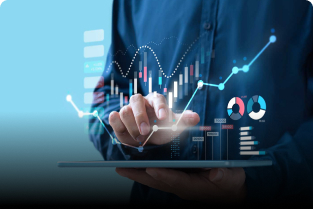Business analytics has evolved significantly over the years, becoming a cornerstone for decision-making in organizations. As technology advances and industries become more data-driven, new trends are emerging that will shape the future of business analytics. Here are the key trends to watch:
1. Increased Use of Artificial Intelligence (AI) and Machine Learning (ML)
AI and ML are revolutionizing business analytics by enabling predictive and prescriptive insights. These technologies allow businesses to:
- Automate data analysis processes.
- Identify patterns and trends in real-time.
- Make accurate predictions for better decision-making.
Example: Retail companies use AI-powered analytics to predict customer behavior and personalize marketing strategies.
2. Growth of Big Data Analytics
The volume of data generated globally is increasing exponentially. Big data analytics tools help organizations:
- Process and analyze massive datasets efficiently.
- Extract valuable insights from unstructured data like text, images, and videos.
- Gain a competitive edge by leveraging comprehensive datasets.
Example: Healthcare providers analyze patient data to improve treatment outcomes and operational efficiency.
3. Rise of Augmented Analytics
Augmented analytics combines AI, ML, and natural language processing (NLP) to simplify data analysis. This trend empowers non-technical users by:
- Automating data preparation and analysis.
- Offering user-friendly interfaces and insights through natural language queries.
- Democratizing access to analytics across organizations.
Example: Business leaders can use augmented analytics tools to generate reports without relying on data scientists.
4. Real-Time Analytics
Organizations increasingly rely on real-time analytics to make instant decisions. This trend is fueled by advancements in:
- Internet of Things (IoT) devices that provide continuous data streams.
- Cloud computing for processing and analyzing data in real-time.
Example: Financial institutions use real-time analytics to detect fraudulent transactions and mitigate risks.
5. Focus on Data Governance and Ethics
With stricter data privacy regulations like GDPR and CCPA, businesses are prioritizing:
- Data governance frameworks to ensure compliance.
- Ethical use of data to build trust with customers.
- Transparent policies for data collection and usage.
Example: Companies are implementing stricter protocols to secure customer data and avoid breaches.
6. Cloud-Based Analytics
Cloud computing is transforming business analytics by providing scalable and cost-effective solutions. Benefits include:
- Easy access to analytics tools and datasets from anywhere.
- Reduced infrastructure costs.
- Seamless integration with other cloud-based applications.
Example: Startups leverage cloud-based analytics platforms to scale their operations without significant upfront investments.
7. Integration of Analytics with Business Processes
Analytics is no longer confined to standalone tools but is being integrated into everyday business processes. This trend enables:
- Continuous improvement through actionable insights.
- Enhanced decision-making at all organizational levels.
Example: CRM systems now include embedded analytics to track sales performance and customer satisfaction.
8. Advanced Visualization Tools
Data visualization tools are becoming more sophisticated, making it easier to interpret complex datasets. Trends include:
- Interactive dashboards for dynamic exploration.
- Use of 3D and augmented reality (AR) for immersive visualizations.
Example: Marketing teams use advanced dashboards to track campaign performance and adjust strategies in real-time.
9. Predictive and Prescriptive Analytics
Predictive analytics forecasts future trends, while prescriptive analytics recommends actions to achieve desired outcomes. Together, they help businesses:
- Optimize operations.
- Enhance customer experiences.
- Drive revenue growth.
Example: Logistics companies use predictive analytics to forecast demand and prescriptive analytics to optimize delivery routes.

